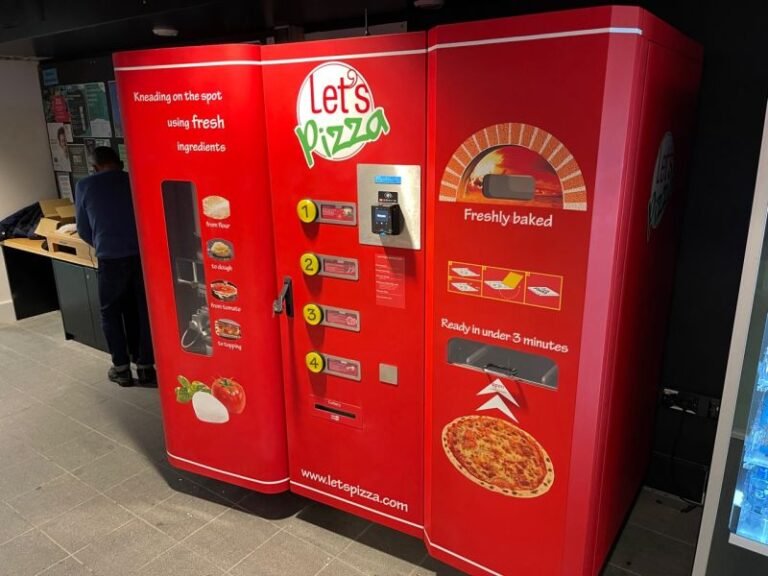Introduction: Why Pizza Vending Machines Are Gaining Traction
In a world that values speed and convenience, pizza vending machines are redefining fast-food norms delivering hot, customizable pizzas 24/7 with just a few taps on a touchscreen. Perfect for urban environments, campuses, or transit hubs, they combine novelty with practicality, delighting consumers while offering entrepreneurs a high-tech, low-labor business model.
Global & UK Market Growth
Market Size and Forecasts
Globally, the pizza vending machine market is experiencing robust expansion. Reports indicate a valuation of $5.8 billion in 2024, projected to reach $9.5 billion by 2030, reflecting a CAGR of ~8.4% . Other sources suggest even higher projections, such as a rise from USD 10.7 billion in 2023 to USD 35.6 billion by 2032. or growth from $1.2 billion in 2023 to $2.9 billion by 2032.
In the UK and Europe, adoption is accelerating. Europe accounted for a $2.0 billion market in 2024, aiming for $3.24 billion by 2030. The UK, with one vending machine for every 55 people, is a fertile ground for innovation in automated food service.
UK-Specific Adoption Trends
Vending Venue LTD is spearheading the UK rollout, offering high-tech machines that make dough, bake, and dispense pizzas on demand with touchscreen interfaces and remote management tools. Londoners are already experiencing 24/7 gourmet pizza via vending units in busy neighborhoods and Bristol boasts the UK’s first-ever pizza vending machine, serving slices in just three minutes.
Understanding Costs
One-Time Expenses
-
Machine purchase: Ranges widely from $30K–$45K USD for basic models to $75K–$109K for premium machines like PizzaForno.
-
Shipping & installation: Typically between $1K–$3K.
-
Branding/wrap: Optional but valuable, around $1K–$2.5K.
-
Licensing & permits: Varies by region; brands like PizzaForno simplify the process via certifications like UL/NAMA.
Ongoing Monthly Costs
-
Location rent/fees: £500–£3,000/month or revenue-sharing deals.
-
Utilities (electricity, internet): About $80–$150.
-
Maintenance: Low, averaging $100–$200; many machines feature remote alerts and automated cleaning systems.
-
Inventory (per pizza): Approximately $2.50–$3.50.
Profit Potential and ROI
Assuming an average sale price of $10–$13 per pizza, selling 15–25 pizzas per day translates to roughly $4,500–$9,750 monthly revenue. After expenses, monthly profit ranges from $1,500–$4,000, with break-even often reached within 8–12 months.
PizzaForno reports 30% net operating margins at approximately $12 per pizza, powered by high uptime and minimal maintenance selling 20 pizzas/day yields $2,500–$3,500 per month profit.
Leading Models & Suppliers in the UK & Europe
Vending Venue LTD (UK)
Their machines deliver on-demand pizza using touchscreen ordering, remote inventory monitoring, and robust construction designed for high-traffic areas.
SmartPizza (France – APITech)
Two models Diva (64-pizza) and Julia (96-pizza) offer remote control for temperature management, stock levels, and branding customization, and can serve hot or cold pizzas using deck ovens.
Let’s Pizza (Croatia/Europe)
This unique machine assembles and bakes a pizza from scratch including kneading and infrared baking in about three minutes, producing up to 100 pizzas per fill.
UK Case Examples
-
London: Machines offer gourmet pizzas at landmark areas and campuses.
-
Bristol: First UK machine delivering fresh pizza in 3 minutes.
Location Strategy & Operations
-
High-traffic hotspots: Transport hubs, universities, and mixed-use developments yield high sales potential.
-
Security first: Insure machines, situate them under surveillance or in monitored areas to avoid vandalism or theft.
-
Remote monitoring: Systems from Vending Venue and SmartPizza help track operations remotely monitoring sales, stock, and maintenance needs.
Step-by-Step Launch Guide
-
Conduct market research: Identify local demand and suitable placement opportunities.
-
Select a supplier & machine type: Compare models, capacities, and support services.
-
Secure location: Negotiate rent or revenue-share agreements.
-
Obtain necessary permits: Use certified machines (e.g., UL/NAMA) to ease compliance.
-
Arrange financing: Consider leasing or small business loans for upfront costs.
-
Set up infrastructure: Install electrical, internet, branding, and delivery logistics.
-
Launch & maintain: Use remote monitoring tools and streamline restocking for efficiency.
Pros & Cons of Pizza Vending Machines
| Pros | Cons |
|---|---|
| 24/7 operation with minimal labor | High initial investment |
| Scalable with remote management | Limited menu variety |
| Novel consumer experience | Technical malfunctions risk |
| Low operating costs, strong margins | Needs optimal placement for ROI |
Expert Tips for Success
-
Start with one test location before expanding.
-
Opt for premium branding to enhance appeal.
-
Keep ingredient lines streamlined for reliability.
-
Use real-time alerts to manage stock and technical issues swiftly.
FAQs
1. How much does a pizza vending machine cost in the UK?
Expect to pay $30K–$109K USD depending on model and features budget for £1K-£3K for setup and branding.
2. What’s the profitability outlook?
With 20 pizzas sold daily at ~$12 each, monthly profit ranges between $2.5K–$4K, often reaching break-even within 8–12 months.
3. Who are notable suppliers in Europe?
-
Vending Venue LTD (UK)
-
SmartPizza (France)
-
Let’s Pizza (Croatia/Europe)
4. What locations work best?
High footfall zones like transport hubs, universities, shopping centers, and urban workplaces.
5. How to cover upfront costs?
Consider equipment leasing, small business or startup loans, or partnerships with brands or landlords.
6. Are these machines difficult to maintain?
No most feature automated cleaning and remote monitoring, with only occasional maintenance required.
